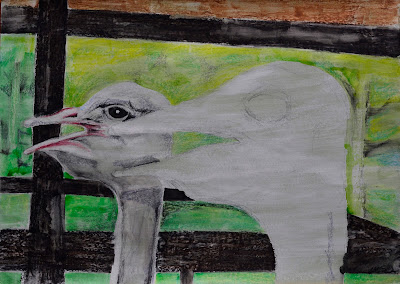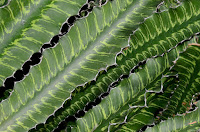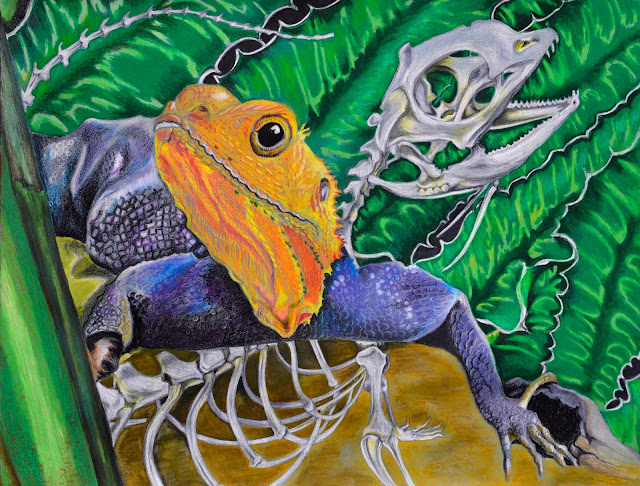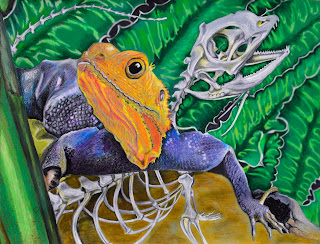For this exercise, I decided to find objects that had unexpected visual connections. While looking around the house I spotted the little clay gargoyle one of my students created last year during art class. I then tried it juxtaposed with the green pepper and chilli peppers I had bought the day before. I really like the odd similarity in shape and color between the green pepper and the gargoyle. Trying to come up with an aesthetically pleasing composition proved to be quite challenging. I started with sketches, but then decided to take a whole lot of photographs with the camera to make a contact sheet to compare and contrast the pros and cons of each arrangement. I decided to alter the heights of the objects by including a fabric-covered box I have for my tea bags. This fabric is a typical western African print in bright greens, dark blue, and turquoise. I knew that the intricacy of the designs on the fabric would be challenging, but I like the way it provided visual interest and directional forces within the composition.
 |
| Sketchbook planning |
 |
| Contact Sheet of possible composition arrangements |
 |
Similar view to the
composition I selected |
I decided to use oil pastels, as I have not worked with them yet in this course. I knew also that it would challenge me to be able to reproduce intricate designs with a medium which is less precise than other drawing media.
This exercise proved to be enjoyable. I followed the guidance of the course manual in using darker tones first and then building up the lighter tones on top. By doing so, I was able to refine my lines to be quite fine in areas. I love the layered effect made possible by the nature of this media. I think I was able to capture the forms of the peppers and gargoyle convincingly, using the direction of my strokes to emphasize the roundness of the bulging forms.
As I had anticipated, the tea bag box proved to be a challenge. What was difficult was to get the patterns to line up correctly, to create the effect of the corners of the edges of the box, and to be able to get the reflections to appear convincing. I found it helpful to use dry chalk pastels on top of the oil pastel to add contrast and highlights.
The draped fabric in the back left-hand corner turned out to be far too light for the rest of the composition. The effect of this was that it tended to draw attention away from the main subject. I then tried to reduce the contrast by making it a grey cloth instead of a cream one. The deadness of the grey then also detracted from the warmth of the table in the foreground. I eventually opted to make the fabric a dull brown. I think that this works better with this composition, allowing the focus to be on the still-life objects. Unfortunately, the multiple attempts at creating the fabric in the back corner caused this area to become a bit pasty and difficult to manipulate.
 |
| Original pastel work with cream cloth |
 |
| Composition with grey cloth |
 |
| Final composition |
What aspects of each drawing were successful, and what did you have problems with?
For my ink drawing, I think that I was successful in creating a contrast between the textural quality of the peppers versus the more haptic and energetic fibrous nature of the matting they were sitting on. I was able to create varied lines with varying line weights to invigorate the textures of the items.
In my pastel drawing, the three-dimensional forms of the peppers are fairly convincing. I feel that the layers work well to render this illusion of form. Where I had difficulties was in making the cloth-covered box totally convincing. I also struggled to get the balance between background and foreground detail.
Did you manage to get a sense of depth in your drawings? What elements of the drawings and still life groupings helped to create that sense?
In my ink drawing, I took almost an aerial perspective viewpoint. This meant that the sense of depth is felt in the items themselves, created through overlapping forms and the suggestion of tonal values using weighted lines and hatching. For the pastel drawing, the angles of the box, overlapping forms and one-point perspective help to give a sense of three-dimensionality. Tonal values play a huge part in creating a sense of solidity in the rounded forms of the peppers and gargoyle.
What difficulties were created by being restricted to line or tone?
When using line on its own, you have to create a sense of tonality through using hatching and cross-hatching, as well as weighted lines to attempt to imply form. When using tones, you have to constantly reference back and forward to check that areas of equal tonality are given the same treatment in your artwork.
How did using colour affect your working method?
I found that using colour caused me to be more critical of how the colours interacted with one another. The lighter cream color of the cloth in the left-hand corner drew attention away from my darker tonal valued subject matter. For this reason, I had to darken the hues and tones of the cloth to make it more subdued. I did enjoy finding subtle references to under tones in the modelling of the peppers and the reflections. Being able to use reds and blues in the shadows helped to invigorate these darker areas, instead of just seeing them as black shadows.



 It was a bit more daunting working on the second male ostrich as he did not have as much of a tonal range as the previous bird. I found that I had to add just touches of color, e.g. the tinges of blue and orange, to add some interest to what could have been a boring surface. Once again, I used wax resist techniques to create layers of tone and to provide an interesting surface texture. I like the contrast between the texture of the crayon shading and the smooth application of washes of color. I think I was able to capture the expression of the second ostrich using finer water-soluble crayon lines applied with a thin brush. I enjoyed adding the finishing touches of fluffy feathers along the eyelid and around the silhouette of the bird.
It was a bit more daunting working on the second male ostrich as he did not have as much of a tonal range as the previous bird. I found that I had to add just touches of color, e.g. the tinges of blue and orange, to add some interest to what could have been a boring surface. Once again, I used wax resist techniques to create layers of tone and to provide an interesting surface texture. I like the contrast between the texture of the crayon shading and the smooth application of washes of color. I think I was able to capture the expression of the second ostrich using finer water-soluble crayon lines applied with a thin brush. I enjoyed adding the finishing touches of fluffy feathers along the eyelid and around the silhouette of the bird.









































